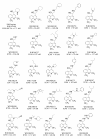Anti-malarial activity of a non-piperidine library of next-generation quinoline methanols
- PMID: 20149249
- PMCID: PMC2833169
- DOI: 10.1186/1475-2875-9-51
Anti-malarial activity of a non-piperidine library of next-generation quinoline methanols
Abstract
Background: The clinical utility for mefloquine has been eroded due to its association with adverse neurological effects. Better-tolerated alternatives are required. The objective of the present study was the identification of lead compounds that are as effective as mefloquine, but exhibit physiochemical properties likely to render them less susceptible to passage across the blood-brain barrier.
Methods: A library of drug-like non-piperidine analogs of mefloquine was synthesized. These compounds are diverse in structure and physiochemical properties. They were screened in appropriate in vitro assays and evaluated in terms of their potential as lead compounds. The correlation of specific structural attributes and physiochemical properties with activity was assessed.
Results: The most potent analogs were low molecular weight unconjugated secondary amines with no heteroatoms in their side-chains. However, these compounds were more metabolically labile and permeable than mefloquine. In terms of physiochemical properties, lower polar surface area, lower molecular weight, more freely rotatable bonds and fewer H-bond acceptors were associated with greater potency. There was no such relationship between activity and LogP, LogD or the number of hydrogen bond donors (HBDs). The addition of an H-bond donor to the side-chain yielded a series of active diamines, which were as metabolically stable as mefloquine but showed reduced permeability.
Conclusions: A drug-like library of non-piperidine analogs of mefloquine was synthesized. From amongst this library an active lead series of less permeable, but metabolically stable, diamines was identified.
Figures



Similar articles
-
Structure-activity relationships amongst 4-position quinoline methanol antimalarials that inhibit the growth of drug sensitive and resistant strains of Plasmodium falciparum.Bioorg Med Chem Lett. 2010 Feb 15;20(4):1347-51. doi: 10.1016/j.bmcl.2010.01.001. Epub 2010 Jan 7. Bioorg Med Chem Lett. 2010. PMID: 20097070
-
Utility of alkylaminoquinolinyl methanols as new antimalarial drugs.Antimicrob Agents Chemother. 2006 Dec;50(12):4132-43. doi: 10.1128/AAC.00631-06. Epub 2006 Sep 11. Antimicrob Agents Chemother. 2006. PMID: 16966402 Free PMC article.
-
Structure-activity relationships of 4-position diamine quinoline methanols as intermittent preventative treatment (IPT) against Plasmodium falciparum.J Med Chem. 2011 Sep 22;54(18):6277-85. doi: 10.1021/jm200647u. Epub 2011 Aug 22. J Med Chem. 2011. PMID: 21854078
-
A Review of Modifications of Quinoline Antimalarials: Mefloquine and (hydroxy)Chloroquine.Molecules. 2022 Feb 2;27(3):1003. doi: 10.3390/molecules27031003. Molecules. 2022. PMID: 35164267 Free PMC article. Review.
-
Quinoline-resistance reversing agents for the malaria parasite Plasmodium falciparum.Drug Resist Updat. 2006 Aug-Oct;9(4-5):211-26. doi: 10.1016/j.drup.2006.09.002. Epub 2006 Oct 24. Drug Resist Updat. 2006. PMID: 17064951 Review.
Cited by
-
New trifluoromethyl triazolopyrimidines as anti-Plasmodium falciparum agents.Molecules. 2012 Jul 10;17(7):8285-302. doi: 10.3390/molecules17078285. Molecules. 2012. PMID: 22781441 Free PMC article.
-
Central nervous system exposure of next generation quinoline methanols is reduced relative to mefloquine after intravenous dosing in mice.Malar J. 2011 Jun 6;10:150. doi: 10.1186/1475-2875-10-150. Malar J. 2011. PMID: 21645370 Free PMC article.
-
Exploring the scope of new arylamino alcohol derivatives: Synthesis, antimalarial evaluation, toxicological studies, and target exploration.Int J Parasitol Drugs Drug Resist. 2016 Dec;6(3):184-198. doi: 10.1016/j.ijpddr.2016.09.004. Epub 2016 Sep 28. Int J Parasitol Drugs Drug Resist. 2016. PMID: 27718413 Free PMC article.
-
Expanding the Antimalarial Drug Arsenal-Now, But How?Pharmaceuticals (Basel). 2011 May 1;4(5):681-712. doi: 10.3390/ph4050681. Pharmaceuticals (Basel). 2011. PMID: 21625331 Free PMC article.
-
Know your enemy: understanding the role of PfCRT in drug resistance could lead to new antimalarial tactics.Cell Mol Life Sci. 2012 Jun;69(12):1967-95. doi: 10.1007/s00018-011-0906-0. Cell Mol Life Sci. 2012. PMID: 22286067 Free PMC article. Review.
References
-
- Shanks GD, Magill AJ, Freedman DO, Keystone JS, Bradley DJ, Steffen R. Drug-free holidays: pre-travel versus during travel malaria chemoprophylaxis. Am J Trop Med Hyg. 2007;77:1–2. - PubMed
MeSH terms
Substances
LinkOut - more resources
Full Text Sources
Other Literature Sources

